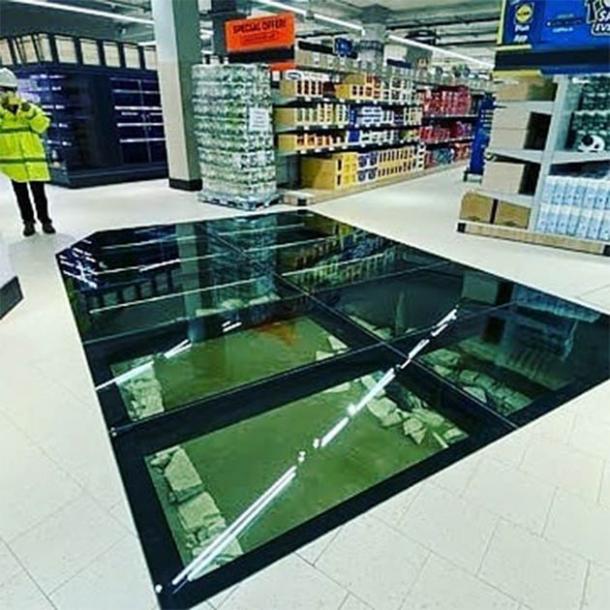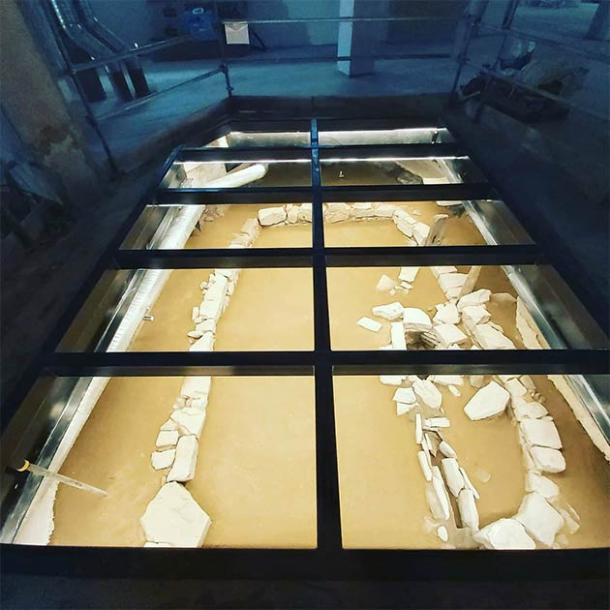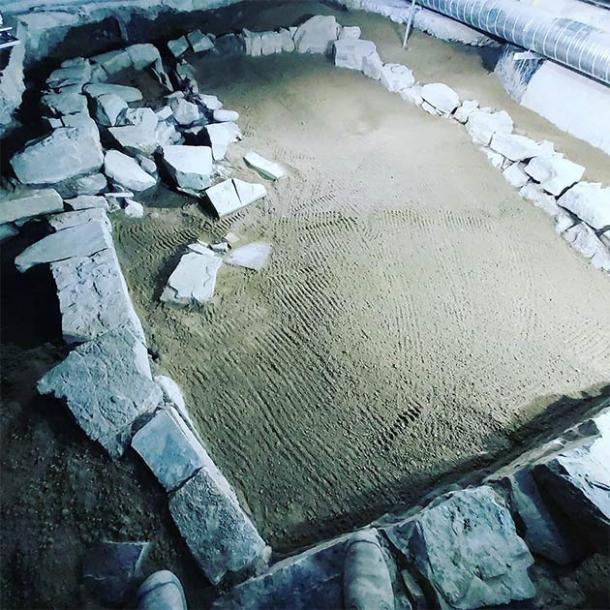A new Lidl supermarket in Ireland is offering shoppers insights as to how the ancient Viking people lived in the city, by making an ancient Hiberno-Norse structure viewable through glass floor panels. The Hiberno-Norse people were descendants of Vikings living in Ireland: they were a mixture of Scandinavian and Gaelic heritage. The new Lidl supermarket on Aungier Street, Dublin was built upon an 11th-century Hiberno-Norse suburb. The Hiberno-Norse structure can now be seen by customers through a glass floor. Archaeologists have dated a series of artifacts found in the Hiberno-Norse structure that suggest the structure was being used around 1070 AD.

The completed glass floor and the Hiberno-Norse structure underneath in the new Lidl supermarket in central Dublin, Ireland designed by the Irish Archaeological Consultancy Ltd . ( Andrew Finney )
Excavating The Sunken Hiberno-Norse Structure
The Viking Age represents a period of time between 700 to 1100 AD, when these fierce Scandinavian sea explorers sailed by longboat to the coastlines of Europe, but they raided Britain and Ireland first, stealing from and burning down churches before they settled in the smoke of these newly conquered territories. Swedish Vikings generally went to the Baltics, while Danish Vikings settled in England. However, it was the Norwegian Vikings who conquered Iceland and Greenland, Scotland and Ireland, and left behind this ancient structure.
The archaeological site director, Paul Duffy, told RTÉ News that the ancient structure was discovered during excavations at the Scape student accommodation development and that it was “a domestic structure within a suburb of Hiberno-Norse Dubliners, who were effectively the ancestors of the Vikings.” The size of the building means it is unlikely to have been a home, but more probably a storage space or where craft activities occurred. The archaeologists say this particular building survived, unlike most 11th-century archaeology, because it was underground, effectively avoiding 1000 years of weathering.

The construction of the glass floor substructure and the Hiberno-Norse structure underneath in the new Lidl supermarket in central Dublin, Ireland, designed by the Irish Archaeological Consultancy Ltd . ( Andrew Finney )
Detailing Viking-Age Structural Dynamics
Built around 1070 AD the Hiberno-Norse structure was created by digging a deep hole that was subsequently lined with locally sourced limestone blocks. To prevent users of the space from the wet muddy base, a wooden plank floor was laid on top of the earth. To further protect the users of the structure, an overarching thatched roof was added. Archaeological evidence suggests that for around a century several generations of Hiberno-Norse used the structure in various ways, and it is known that it had burned to the ground at least once. Excavations revealed that after the fire, the structure was rebuilt with “a raised clay floor, a realigned entrance passage, a new doorway” and the renovations even included “a stone-lined cistern fed with water from outside by a gully,” according to a report in the Daily Mail .
While this ancient structure might be unique among supermarkets in general, it is but one among three such attractions at this Lidl store. According Paul Duffy, this Lidl supermarket also features the remains of the 18th century Aungier Theatre staircase and the Longford Street Arches. Speaking of these two additional archaeological attractions, Vincent Cronolly of Lidl Ireland told RTÉ that the store has showcased all three, and that a lot of interpretation panels are in place throughout the store to inform customers as to what they are looking at, and how these features might have functioned.

The Hiberno-Norse structure underneath in the new Lidl supermarket in central Dublin, Ireland, designed by the Irish Archaeological Consultancy Ltd ( Andrew Finney )
Ireland’s Ancient Scandinavian Heritage
Since the late 1700s at least 77 Viking burials have been discovered and excavated across the city of Dublin at sites such as South Great George’s Street, where archaeologists have uncovered dozens of Viking burials. According to an article on Archaeology.org, when researcher Linzi Simpson from Dublin’s Trinity College carbon dated the artifacts and human remains from this site they showed that the men had been buried in Irish soil “decades, before the accepted date for the establishment of the first year-round Viking settlement in Dublin,” and perhaps even before the first known Viking raid on the island took place.
As the Vikings continued their raids on Ireland during the 9th-century they settled around the country at Waterford, Cork, Dublin, Wexford and Limerick. These were all developed as trading centers by the Vikings and later became the towns and cities we know today. According to Irish Central , Dublin’s magnificent Christ Church Cathedral, is by far the most famous cathedral in Ireland, and today it continues to be a big draw for tourists. The cathedral was built around the year 1030 AD by Silkbeard, the Norse King of Dublin, only 40 years before the structure beneath the Lidl store was built.
Top image: The glass floor and the Hiberno-Norse structure underneath in the new Lidl supermarket in central Dublin, Ireland, designed by the Irish Archaeological Consultancy Ltd . Source: Andrew Finney
By Ashley Cowie
Related posts:
Views: 0
 RSS Feed
RSS Feed















 October 27th, 2020
October 27th, 2020  Awake Goy
Awake Goy  Posted in
Posted in  Tags:
Tags: 
















